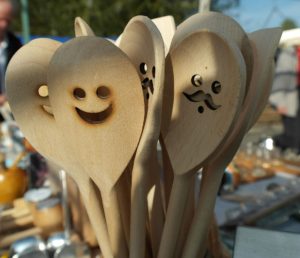 The top 5 cooking utensils for a kitchen is essential to know about, and have available when you’re cooking. The home kitchen is a small scale of a commercial kitchen, and food preparation is very similar, but again, just done on a smaller scale. However, that doesn’t mean that one should go without good quality cooking tools.
The top 5 cooking utensils for a kitchen is essential to know about, and have available when you’re cooking. The home kitchen is a small scale of a commercial kitchen, and food preparation is very similar, but again, just done on a smaller scale. However, that doesn’t mean that one should go without good quality cooking tools.
High quality utensils means that you will own those same tools well into the future (my Mom still has some cooking utensils from when I was 5 years old, and I’m about to turn 51 years old, in a couple weeks).
In particular, knives. Don’t ever skimp and cheap out when buying knives, or cutlery. It may sound counter-intuitive, but a high quality knife can be sharpened to a laser-edge, and can save your fingers from becoming victims. How is that possible, you may ask. Well, it’s quite simple, really. A sharp knife won’t slip off of whatever you’re cutting, and plunge into your finger.
Chef’s Knife
The chef knife could possibly be the most commonly used kitchen utensil, and as discussed above, you should therefore, not buy a cheap one. In days gone by, this style of knife was mainly used to cut beef, including through joints and cartilage. Today, this is the utilitarian knife in the arsenal, and so must be comfortable for the cook or chef, as the case may be.
Typically, the blade is 8 inches, but the range is from 6 inches to 14 inches. There are two main blade styles. French and German. The French knife has a straighter blade along the cutting edge, an then curves up towards the end, near the tip of the knife. The German knife has more of a continuous curve along the cutting edge. One is no better than the other…it’s just personal preference. Other cultures have different ideas of what a Chef’s knife is. Take the Chinese, for example. Their chef’s knife looks like a cleaver.
Having your knife sharp is imperative for safety, and accuracy. To that end, always keep a “steel” in your drawer, This is the sharpening rod, that you can use each time you plant to put your chef knife to work. You don’t need to spend 20 minutes sharpening, but a a dozen or so strokes, regularly will keep the blade sharp always.
Cutting Board
What a more fitting utensil after the chef’s knife, than a cutting board? This is an absolute must, and not an option. Think about it…what surface are you going to cut on? The counter top, a plate, a pan, or a platter…. None of the above, for obvious reasons. You’ll get a cutting board…end of story! So, the next question is what type of cutting board…
The most common materials are wood and plastics, such as corian or nylon. However, there are some other options like marble, steel, rubber, silicone or glass. the latter 3 are much easier to clean than the wood or plastic, but they also have a down-side. Due to how hard these boards are, they expertly dull knives. So, you have to weigh out the pros and cons. The glass and marble boards are also easier to keep germ-free. There have been many studies to try and determine which material of board is the easiest sanitize, and/or can naturally self-sanitize. None of them are conclusive…so, use your common sense, and clean things properly, the same way you would clean a stainless steel pan.
Cross contamination is another issue. For example, you have a party and need to cut up fresh veggies, and fruit for platters. So, don’t use the wooden cutting board that you usually hack up chicken on. Use a different board that’s only used for fruits and vegetables or cheese. There are a few more considerations when buying cutting boards, but if you follow the advice here, you should be fine. Just use your noodle!
Tongs – Spatulas – Wooden Spoons
I placed all these items under one category, because they all do something a bit similar…sort of… Of course they all have a different function. You can’t stir a pot of stew with tongs, and you can’t flip eggs with a wooden spoon…lol. Seriously, where would you be without any one of these items. They’re all so important. When purchasing these items, get the good stuff. You don’t want things breaking while you’re in the middle of cooking.
Tongs come in many styles. We have a multitude of tongs in our utensil drawer. Our personal favorite is the metal tongs with the silicone grippers (they look like little hands), and of course the heavy metal barbecue grill tongs are a must. Wooden spoons can be bought at a dollar store, but I hate the way they feel, and how easily they can break. If the wooden spoon is too light, it doesn’t feel right. Get a spatula with a thin front edge. It will slide under eggs etc and thus, make your life much easier, when making eggs for your better half. You won’t be serving scrambled eggs when they want sunny side up.
Mixing Bowls
Where would we be without mixing bowls. How could you beat up a few eggs for an omelette, or make a pancake batter etc. Yes, everyone has to have a set of bowls for combining ingredients, and mixing up a few eggs. The easiest bowls to work with are stainless steel, and glass comes in at a close second.
Occasionally, you will have a left over mixture in your bowl, and it would be a shame to throw it away. So, consider buying bowls that come with lids. Then you can store it straight into the fridge. When you’re choosing which bowls to purchase, makes sure there are enough sizes. It will make your life much easier, if you are baking, especially. Also, your bowl set will be within a certain range of size, but every once in awhile, you’ll need a massive bowl. So, it’s a smart idea, to go and get a gargantuan stainless steel bowl. I bought one just for making my bean salad, as I use around a dozen cans of beans, and legumes etc. Very handy, indeed!
Measuring Spoons & Cups
Okay, so how would you measure liquids and certain dry ingredients, if you didn’t have a measuring cup or a measuring spoon? Right….you wouldn’t be able to. Which would mean, no baking for you. Baking is based on measurements, and there’s usually no deviation, and an extremely small tolerance. Mainly because, baking is pure science, so you can’t mess with the recipe.
Cooking on the other hand, is not as a scientific. Well, there is also science involved, but it is way more forgiving, and the tolerances are much greater. I don’t measure over 90% of the time, when I cook….and I haven’t killed anyone yet, lol!
Bottom line, get yourself some good measuring cups, little spoons, and a scale. Some baking recipes call for a certain weight of an ingredient. The kitchen digital scales are fairly inexpensive, and are surprisingly accurate. Measuring devices in a kitchen are a necessary staple, if you take food preparation seriously, and enjoy cooking.
Remember, a well-equipped kitchen, makes for a happy chef. Bon Appetit!
